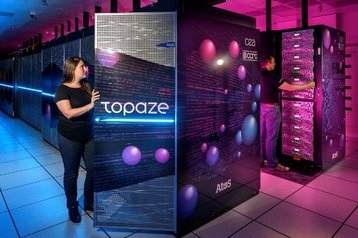Atos has delivered a new supercomputer to the French Alternative Energies and Atomic Energy Commission (CEA) and Research and Technology Computing Center (CCRT) with triple the processing power of the previous system.
The new Topaze system is based on Atos’ BullSequana XH2000 and installed in the CEA's Very Large Computing Center (TGCC) at Bruyères-le-Châtel in Essonne, south of Paris.
The result of joint R&D efforts by Atos and the CEA's Military Applications Directorate (DAM), the new system has a peak computing power of around 8.8 petaflops. It replaces an Intel-based 2.4 petaflops system from Atos named COBALT that was commissioned in 2016.
Topaze has 864 nodes equipped with the AMD Epyc Milan 7763 processors, an accelerated partition of 48 nodes based on Nvidia A100 processors, and four very large memory nodes. A DDN storage system with a capacity of approximately three petabytes and a bandwidth of 280 gigabytes/s completes the computation part.
Through partnerships with CCRT, teams from ArianeGroup, the CEA, Cerfacs, EDF, France Génomique, IFPEN, Ineris, Ingeliance, IRSN, L'Oréal, Michelin, Onera, the Safran Group, Synchrotron SOLEIL, TechnicAtome, Thales Defence Mission Systems, Thales Alenia Space and Valeo will be able to utilize the system.
Atos this week also announced it was to deliver a new supercomputer to Paderborn University in Germany.
Noctua 2 will expand the original Cray CS500 Noctua system installed in 2018. The new system will be installed at the new HPC facility at the Paderborn Center for Parallel Computing (PC2) by the end of the year.
“With Atos, we have an industry-leading partner at our side. The Paderborn Center for Parallel Computing gives top researchers access to ultramodern computing capacity. In order to take the next step toward future security in this area, we need experienced experts to help us develop and operate energy-efficient HPC systems. Atos impressed us with its decades of experience,” says Prof. Dr. Christian Plessl from Paderborn University and Chair of the PC2.
Half of the new system’s €14 million ($16.7 million) investment is being financed by the State of North Rhine-Westfalia and the federal government’s research buildings program, as well as through investment resources from the newly founded Verbund der Nationalen Hochleistungsrechenzentren (Association of National High-Performance Computing Centers, NHR).




